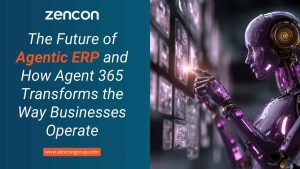Running a business today means making fast decisions based on accurate data. Yet many companies still struggle with manual data entry, slow reporting, and disconnected systems. Even small errors in data can lead to poor forecasting, missed opportunities, and lost revenue.
With artificial intelligence (AI) now built directly into Microsoft Dynamics 365, businesses are starting to move past these challenges. AI brings automation, prediction, and real-time accuracy into ERP systems, helping teams make better decisions and work more efficiently.
Why Data Accuracy Matters in ERP Systems
ERP data is the backbone of every business decision — from finance and operations to inventory and customer engagement. When this data is inconsistent, outdated, or incomplete, every report and forecast built on it becomes unreliable.
For example, if your sales data and inventory updates are delayed by even a day, your forecast for the next week may be off by thousands of dollars.
Traditional ERPs often depend on human input and manual validation. This process is not only time-consuming but also prone to human error. AI in Dynamics 365 solves this problem by using automation and predictive modeling to keep data accurate and consistent at every step.
How AI Improves Data Accuracy in Dynamics 365
Microsoft has embedded AI tools across the Dynamics 365 ecosystem to improve data quality automatically. Here are a few key ways it helps:
- Automated Data Validation: AI continuously checks for missing fields, duplicate entries, or inconsistent data formats. It alerts users and corrects errors before they affect reports or financials.
- Real-Time Updates: With connected data sources, AI ensures every department is working with the latest information. Sales, finance, and operations teams all see the same numbers at the same time.
- Intelligent Data Matching: AI can link related records automatically, such as matching invoices with payments or purchase orders with receipts, reducing manual reconciliation.
- Predictive Cleaning: The system learns from past data corrections and automatically applies the same logic to new records, improving accuracy over time.
How AI Enhances Forecasting in Dynamics 365
Accurate forecasting has always been one of the toughest challenges for business leaders. Traditional forecasting often relies on past data alone, without accounting for changing market conditions or new customer behaviors.
AI in Dynamics 365 changes that completely.
- Predictive Analytics: Using historical data, AI identifies trends and patterns that humans might overlook. It helps forecast revenue, inventory needs, or demand spikes more accurately.
- Scenario Planning: Businesses can now test multiple what-if scenarios. For example, what happens if sales rise by 20 percent next quarter or if supplier delays increase by two weeks? AI models can simulate these outcomes instantly.
- Dynamic Forecast Adjustments: AI models continuously learn from new data. When actual sales numbers or expenses differ from predictions, the system automatically adjusts future forecasts.
- Integrated Power BI Visualization: Dynamics 365 works seamlessly with Power BI to turn AI forecasts into interactive dashboards. Decision-makers can explore real-time insights without waiting for manual reports.
Real-World Example: A Manufacturing Firm’s AI Journey
A mid-sized manufacturing company using Dynamics 365 Business Central faced recurring issues with inaccurate demand forecasting. Production teams often made extra units that sat in warehouses for weeks, while other high-demand products ran out of stock.
By enabling AI-driven forecasting and data validation within Dynamics 365, they were able to:
- Reduce forecast error rates by over 35 percent
- Improve production planning and lower inventory costs by 20 percent
- Deliver real-time insights to management through connected Power BI dashboards
This example highlights how AI can transform everyday ERP operations, making them more reliable and profitable.
Why Dynamics 365 Is Leading This Change
Unlike older ERP systems, Dynamics 365 is built on Microsoft’s cloud infrastructure and integrates tightly with the Microsoft Power Platform, Azure AI, and Copilot.
This means every user has access to AI tools for automating data entry, improving forecasting, and visualizing business performance — without needing custom code.
The result is an ERP that learns and improves continuously, making decisions faster and smarter every day.
Moving Forward
As AI continues to evolve, the gap between traditional ERP systems and intelligent platforms like Dynamics 365 will only grow wider.
Businesses that embrace AI-driven data accuracy and forecasting now will gain a major competitive edge. They will be able to plan better, adapt faster, and achieve sustainable growth even in unpredictable markets.
If your company is still relying on manual reporting and outdated forecasting methods, now is the time to explore what Dynamics 365 can do.
📩 Want to see how AI in Dynamics 365 can improve your forecasting accuracy and business reporting?
Get in touch with our team of experts today: https://zencongroup.com/contact-us/



